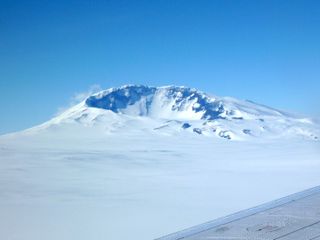
Giant Blob of Hot Rock Hidden Under Antarctic Ice

SAN FRANCISCO — A big, hot blob hiding beneath the bottom of the world could be evidence of a long-sought mantle plume under West Antarctica, researchers said Monday (Dec. 9) here at the annual meeting of the American Geophysical Union.
The possible hotspot — a plume of superheated rock rising from Earth's mantle — sits under Marie Byrd Land, a broad dome at West Antarctica's edge where many active volcanoes above and below the ice spit lava and ash. The hot zone was discovered with seismic imaging techniques that rely on earthquake waves to build pictures of Earth's inner layers, similar to how a CT scan works. Beneath Marie Byrd Land, earthquake waves slow down, suggesting the mantle here is warmer than surrounding rocks. The strongest low-velocity zone sits below Marie Byrd Land's Executive Committee Range, directly under the Mount Sidley volcano, said Andrew Lloyd, a graduate student at Washington University in St. Louis.
"The slow velocities suggest that it's a mantle hotspot," Lloyd said. The hot zone also matches up with Marie Byrd Land's high topography and active volcanoes, Lloyd said. [WATCH LIVE: News on Earth & Mars at AGU 2013]
Mantle plume?
Many researchers have long suspected that Marie Byrd Land sits atop a hotspot, because the region swells above the surrounding topography like the top of a warm soufflé (and it has lots of volcanoes). But with few seismometers sitting on the ice, scientists were left speculating about what lies beneath Antarctica's ice.
The evidence for the new hot zone, called a thermal anomaly, comes from a massive, temporary earthquake-monitoring network called Polenet that was installed between 2010 and 2012, giving scientists an unprecedented look at Antarctica's crust and mantle. (A gravity survey conducted at the same time also suggests there is a big warm spot beneath this part of West Antarctica.)
But confirming that Marie Byrd Land is truly above a hotspot may require a return trip to Antarctica for another seismic experiment, said Doug Wiens, principal investigator on Polenet.
Sign up for the Live Science daily newsletter now
Get the world’s most fascinating discoveries delivered straight to your inbox.
"What's absolutely sure is there's a big thermal anomaly, a big blob," said Wiens, a seismologist at Washington University. "What's less sure is whether that anomaly goes deeper."
The thermal anomaly extends 125 miles (200 kilometers) below Marie Byrd Land, Lloyd said. Below about 255 miles (410 km), where a mantle plume's trailing tail would also leave a hotter-than-average mark in mantle rocks, there's little evidence for a rising hotspot, said Erica Emry, a postdoctoral researcher at Pennsylvania State University.
"There's no smoking gun," Emry said. However, more work remains to be done on the Polenet data, which could reveal new clues and further refine what the mantle looks like under West Antarctica, Emry told LiveScience's OurAmazingPlanet.
Antarctica's thinnest crust
The discovery is one of many new insights reported Monday into the geologic mysteries concealed by Antarctica's thick ice. Other findings include extremely thin crust, just 10 miles (17 km) thick, in West Antarctica's Ross embayment near the Transantarctic Mountain Range, said Xinlei Sun, a postdoctoral researcher at Washington University. The Ross embayment is one of Antarctica's two big coastal divots; the gap is filled by the Ross Ice Shelf. Here, the crust is as thin as in the Gulf of California, where continental rifting (also called extension) is tearing Baja California from mainland Mexico and building a new ocean basin.
"This is the thinnest crust [in Antarctica] and is probably related to an extensional environment," Sun said.
On the other side of the Transantarctic Mountains lies the thick, old crust of East Antarctica, similar to the relatively stable interiors of continents such as North America and Africa. Antarctica's thickest crust is found here, beneath the Gamburtsev Mountain Range. The Gamburtsevs are spectacular Alpine peaks completely buried in ice; the crust here is about 31 miles (50 km) thick. The crust beneath Marie Byrd Land is about 15 miles (25 km) thick, Sun said.
Email Becky Oskin or follow her @beckyoskin. Follow us OurAmazingPlanet @OAPlanet, Facebook and Google+. Original article at LiveScience's OurAmazingPlanet.

Most Popular

